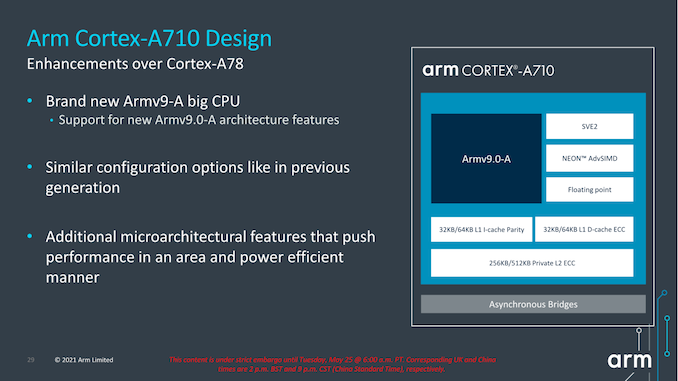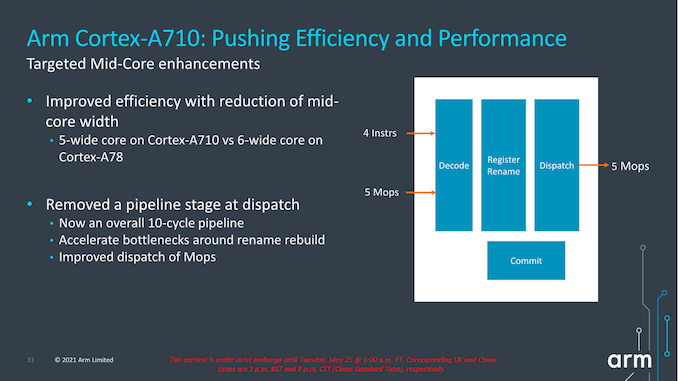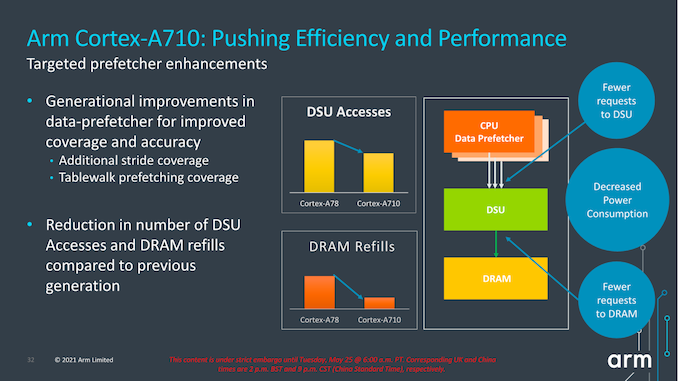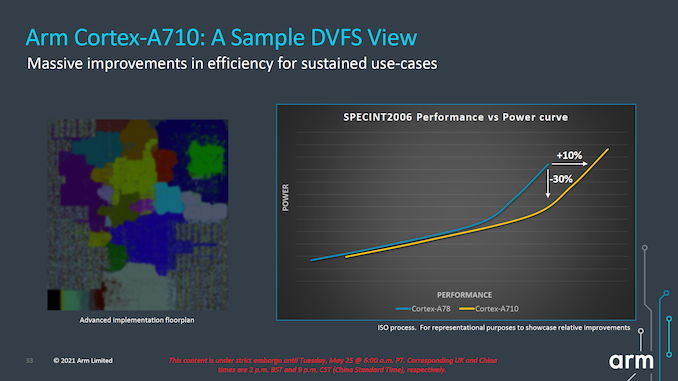Arm Announces Mobile Armv9 CPU Microarchitectures: Cortex-X2, Cortex-A710 & Cortex-A510
by Andrei Frumusanu on May 25, 2021 9:00 AM EST- Posted in
- SoCs
- CPUs
- Arm
- Smartphones
- Mobile
- Cortex
- ARMv9
- Cortex-X2
- Cortex-A710
- Cortex-A510
The Cortex-A710: More Performance with More Efficiency
While the Cortex-X2 goes for all-out performance while paying the power and area penalties, Arm's Cortex-A710 design goes for a more efficient approach.
First of all, the new product nomenclature now is self-evident in regards to what Arm will be doing going forward- they’re skipping the A79 designation and simply starting fresh with a new three-digit scheme with the A710. Not very important in the grand scheme of things but an interesting marketing tidbit.
The Cortex-A710, much like the X2, is an Armv9 core with all new features that come with the new architecture version. Unlike the X2, the A710 also supports EL0 AArch32 execution, and as mentioned in the intro, this was mostly a design choice demanded by customers in the Chinese market where the ecosystem is still slightly lagging behind in moving all applications over to AArch64.
In terms of front-end enhancements, we’re seeing the same branch prediction improvements as on the X2, with larger structures as well as better accuracy. Other structures such as the L1I TLB have also seen an increase from 32 entries to 48 entries. Other front-end structures such as the macro-OP cache remain the same at 1.5K entries (The X2 also remains at 3K entries).
A very interesting choice for the A710 mid-core is that Arm has reduced the macro-OP cache and dispatch stage throughputs from 6-wide to 5-wide. This was mainly a targeted power and efficiency optimization for this generation, as we’re seeing a more important divergence between the Cortex-A and Cortex-X cores in terms of their specializations and targeted use-cases for performance and power.
The dispatch stage also features the same optimizations as on the X2, removing 1 cycle from the pipeline towards an overall 10-cycle pipeline design.
Arm also focuses on core improvements that affect the uncore parts of the system, which take place thanks to the new improvements in the prefetcher designs and how they interact with the new DSU-110 (which we’ll cover later). The new combination of core and DSU are able to reduce access from the core towards the L3 cache, as well as reducing the costly DRAM accesses thanks to the more efficiency prefetchers and larger L3 cache.
In terms of IPC, Arm advertises +10%, but again the issue with this figure here is that we’re comparing an 8MB L3 cache design to a 4MB L3 cache design. While this is a likely comparison for flagship SoCs next year, because the Cortex-A710 is also a core that would be used in mid-range or lower-end SoCs which might use much smaller L3 caches, it’s unlikely we’ll be seeing such IPC improvements in that sector unless the actual SoCs really do also improve their DSU sizes.
More important than the +10% improvement in performance is that, when backing off slightly in frequency, we can see that the power reduction can be rather large. According to Arm, at iso-performance the A710 consumes up to 30% less power than the Cortex-A78. This is something that would greatly help with sustained performance and power efficiency of more modestly clocked “middle” core implementations of the Cortex-A710.
In general, both the X2 and the A710’s performance and power figures are quite modest, making them the smallest generation-over-generation figures we’ve seen from Arm in quite a few years. Arm explains that due to this generation having made larger architectural changes with the move to Armv9, there has been an impact in regards to the usual efficiency and performance improvements that we’ve seen in prior generations.
Both the X2 and the A710 are also the fourth generation of this Austin microarchitecture family, so we’re hitting a wall of diminishing returns and maturity of the design. A few years ago we were under impression that the Austin family would only go on for three generations before handing things over to a new clean-sheet design from the Sophia team, but that original roadmap has been changed, and now we'll be seeing the new Sophia core with larger leaps in performance being disclosed next year.















181 Comments
View All Comments
ikjadoon - Tuesday, May 25, 2021 - link
Fair; I'll take a K12 successor as recompense.The business side is good context I forgot, but now in 2021, AMD is in much better straits and surely K12's successor is worth a shot.
https://www.anandtech.com/show/7990/amd-announces-...
Surely there were great ideas in Keller's work, their team's work, in their post-Styx designs
AMD might find a lot of benefit in preparing an Arm roadmap. What's to stop consoles, laptops, desktops from switching to Arm, from AMD"s financial perspective? Hopefully, they have clear eyes on x86's relevance to both consumers & businesses. AMD has a knack for fighting back, so I hope the build on their financial momentum.
TheinsanegamerN - Wednesday, May 26, 2021 - link
Compatibility, performance, and existence.ARM brings compatibility issues with previously existing software. Emulation wont work 100%,a nd compatibility with existing hardware is a minefield
With that emulation/compatibility layer comes performance degregations. Sometimes it may not be so bad, other times it will be horrendous. The overall software market is not as tightly controlled as apple's walled garden approach.
And finally, existence. There is currently no high performance ARM processor in existence. Show me a desktop ARM process ro that could replace a 5900x or a 10900k. How about one that could replace the CPU in the PS5? Currently one does not exist. You could say one exists for laptops, but that is only available for apple.
mode_13h - Thursday, May 27, 2021 - link
> There is currently no high performance ARM processor in existence.There are probably a dozen ARM server processors on the market or still in service that would fit a reasonable definition of high-performance.
> Show me a desktop ARM processor that could replace a 5900x or a 10900k.
I see you stuck that word "desktop" in there. Desktop is probably the last market ARM would penetrate. So, if your point is that you won't take ARM seriously until there's a competitive ARM-based desktop offering, that's like reaching for the fire extinguisher once you're surrounded by flames instead of when you first smell smoke.
I'm eager to see what V1-based CPUs look like. Those cores could make for a viable workstation CPU.
mode_13h - Tuesday, May 25, 2021 - link
And don't forget about Chinese designs (although this one is mentioned as being A72-derived):https://en.wikichip.org/wiki/hisilicon/microarchit...
SarahKerrigan - Tuesday, May 25, 2021 - link
The KP920 core isn't A72 derived. It says "from A72" but all it's saying there is that its predecessor used A72's - it's not saying the core is derived from A72's.That being said, with Phytium and Hisilicon cut off from TSMC, mainland core development may not result in compelling silicon any time soon.
eastcoast_pete - Tuesday, May 25, 2021 - link
Fair point on "no custom cores". However, I don't expect any custom cores from Ampere coming to a smartphone near me anytime soon, and QC seems to want Nuvia's IP mostly for larger systems. Neither strikes me as a source for efficiency cores in the mobile space. QC may incorporate Nuvia's tech into big cores for its SoCs , but I doubt they'd even do that.eastcoast_pete - Tuesday, May 25, 2021 - link
Addendum: ".. anytime soon" to the end of the last sentence. They probably will try big cores for their SoCs, but I'm afraid they'll pair those with A510 LITTLE cores.mode_13h - Wednesday, May 26, 2021 - link
> I'm afraid they'll pair those with A510 LITTLE cores.As opposed to what? We saw nothing to suggest the A510 is *worse* than A55. And if you're doing ARMv9, then there are no other options (except proprietary).
Also, why are you freaking out over A510? It's a little underwhelming, but it's not *bad*.
mode_13h - Wednesday, May 26, 2021 - link
> QC seems to want Nuvia's IP mostly for larger systemsNo. Nuvia said they were building server cores, but Qualcomm's messaging around the acquisition was that Nuvia will build cores showing up in mobile SoCs, first.
They didn't rule out the possibility of larger systems, but that's clearly not their priority.
roboman21 - Tuesday, May 25, 2021 - link
Apple is lightyears ahead and it is due in no small part to this acquisition:https://www.anandtech.com/show/3665/apples-intrins...
This is tough to pull of but it can yield advantages to a competitor with the same ARM core and 7nM semiconductor process.